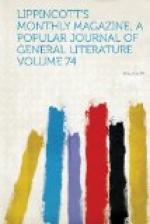Here “The Professor” found his long-sought sweetheart kneeling at a new-made grave, under these overhanging trees. And here we found the shrine of poor Charlotte Bronte’s many weary pilgrimages hither,—the burial-place of her friend and schoolmate Martha Taylor, the Jessy Yorke of “Shirley,” the spot where, under “green sod and a gray marble headstone, cold, coffined, solitary, Jessy sleeps below.”
THEO. WOLFE.
COOKHAM DEAN.
For a long time “the Dean” had had a certain familiarity for us. We heard it continually spoken of among our artist friends, and had even come to recognize many of its picturesque features as we came across them in our usual studio-haunts and in the exhibitions. We seemed to know those green, billowy swells at sight, as well as the thatched and tiled roofs and old-fashioned gardens, the swinging barred gates and stagnant, goose-tormented pools,—even the coarse-limbed rustics in weather-beaten “store-clothes,” picturesque only in mellow fadedness.
We knew all this; yet, when we set eyes and feet upon Cookham Dean for the first time, behold, the half had not been told us! We had directed many a letter to Cookham Dean, and knew them to have been duly delivered by a bucolic postman on a tricycle. But a hundred canvases, and almost as many tongues, had failed to tell us of the sunny slopes and shadowy glades, the sylvan lanes and ribbon-like roads, the old stone inn with open porch and sign swinging from lofty post set across the way, as Italian campanile stand away from their churches, all coming under the name of “Cookham Dean,” although that “Dean,” properly speaking, is only their geographical and artistic centre.
Long before we reached Ye Hutte from Cookham station—Ye Hutte set amid bushy and climbing roses upon a prominent knoll of the many-knolled Dean—we ceased to wonder that our picturesque imaginings of the region we were passing through had been so various. Artists were before us, artists behind us, artists on every side of us, two sketching-umbrellas glinting like great tropical flowers in a corn-field, another like a huge daisy in the dim vista of a long lane.
“C—— lodges in that red cottage, B—— in the next one, H—— in this tumble-down farm-house, the L——s in that row of laborers’ cottages, the D——s in the inn,” said Mona, tripping lightly over well-known names, whose most accustomed place is in the exhibition catalogues.
Through the open windows of a hideous brick row, built to hold as many laborers’ families all the year round and as many Bohemian summer artists as can crowd therein, we caught glimpses of tapestries worth their weight in gold. One well-known artist has taken possession of the end of this uncomely row, intended for a supply-shop to the neighborhood. This shop is his studio, which he has filled with treasures of Japanese art. As a Cookhamite assured us, “Mr. C—— goes in for the Japanesque;” and he screens the large display-windows intended for cheese, raisins, and potted meats with smiling mandarins and narrow-eyed houris under octopus-like trees.




